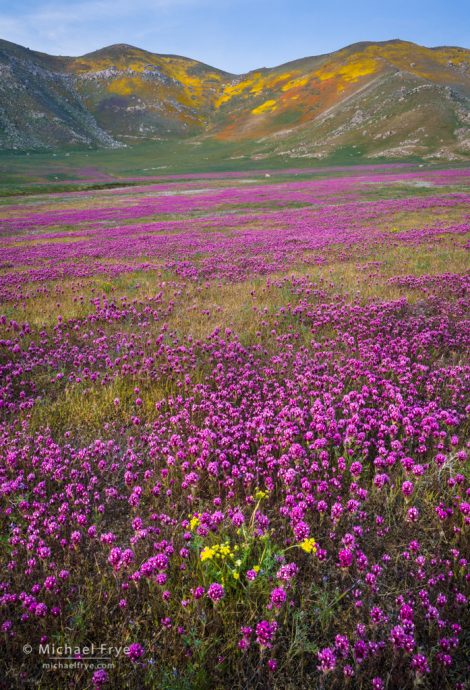
Poppies, goldfileds, owl’s clover, and spring gold, southern Sierra Nevada, California. There were two compositional challenges here: the physical distance between the foreground and background flowers, plus the lack of any distinguishing features in the foreground that could serve as a focal point. I found this slightly-elevated vantage point where I could show the sweep of owl’s clover leading up to the hills, allowing me to fill most of the frame with flowers, so that solved the first problem. And then I spotted this small clump of yellow flowers (spring gold), which added a foreground focal point, and tied in visually with the yellow colors in the background. 27mm, 1/10th of a second at f/16, ISO 800.
It’s been a good year for wildflowers in California – above average in some places, and exceptional in a few spots.
One of those places that seemed to be having an exceptionally-good year was Antelope Valley, so after our Death Valley workshop Claudia and I made a quick trip down there. We had seen poppies in Antelope Valley back in the late ’80s, but hadn’t been back since, so this seemed like a good time for a return visit. And the flowers were amazing. In the sun the combination of bright, red-orange poppies and yellow goldfields was downright blinding. It actually hurt my eyes to look directly at the flowers.
But while the flowers were amazing, so was the wind. Antelope Valley is a notoriously windy place. It’s a big, wide-open plain with only scattered trees, and it’s on the eastern, downslope, and therefore windy side of the Tehachapi Mountains. There are wind turbines there for a reason.
Weather is always important in landscape photography. Usually we’re most concerned about clouds (or the lack of clouds), but for flowers wind might be the most important weather factor. Sure, I’d like to have clouds; the soft light created by overcast skies is perfect for colorful subjects like flowers. But I can make sunshine and cloudless skies work, while wind really limits what kind of photographs I can make.
We timed our visit to Antelope Valley to coincide with one morning that forecasts indicated might be calm – out of a week of windy days. And that morning was calm, sort of. Not perfectly still, but workable. A few high clouds passed by, occasionally softening the light a little, which helped. The wind picked up again in the afternoon, and didn’t let up, but at least we had one good morning there. It was also fun to meet up with our friends Mary Liz Austin and Terry Donnelly.
Even without wind, wildflower photography can be challenging. I wrote a post a while ago called “Color is not Enough,” and nowhere is that more true than when photographing flowers. It’s easy to get overwhelmed by all the color, and forget about design. But design and composition are always essential. You can’t just point your camera at a colorful field of flowers and expect to make a compelling photograph.
When working with students on composition, I seem to repeat the same things over and over: look for patterns and focal points, and fill the frame with interesting stuff. There’s obviously a lot more to composition than that, but those three principles can help immensely. In this small portfolio of wildflower photographs I’ve included extended captions where I talk about those factors in each composition.
The big wildflower displays in Southern California are fading, but the wildflower season will last well into the summer in the mountains. If you photograph flowers, just remember to look to patterns and focal points, and fill the frame with interesting stuff. And pay attention to the wind forecasts!
— Michael Frye
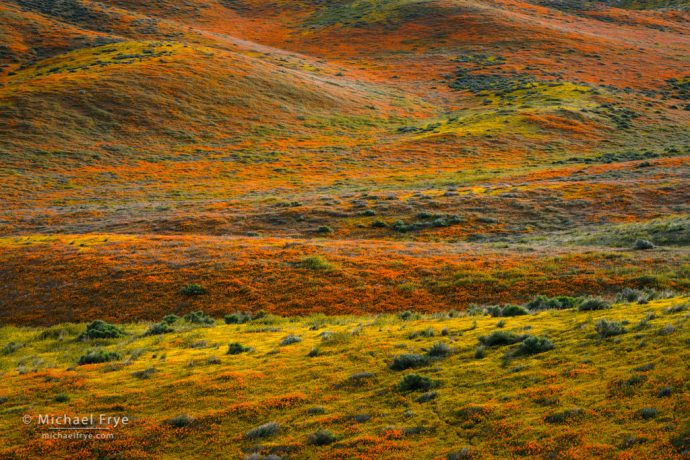
Hills covered in poppies and goldfields, Antelope Valley, California. I loved the patterns created by the colors and folds in these hills, so I used a telephoto lens (130mm) to fill the frame with those patterns. 1/125th of a second at f/16, ISO 250.
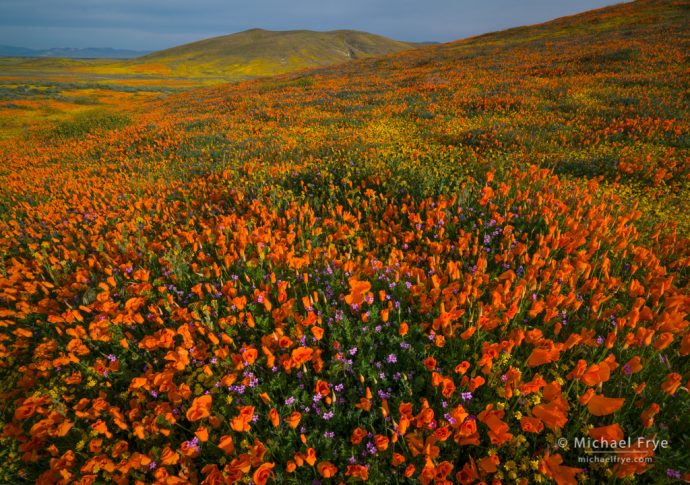
Poppies, goldfields, and gilia, Antelope Valley, California. A classic wide-angle, near-far composition, filling the frame with the dense flowers. The circular clump of poppies near the bottom is one focal point, while the distant hill adds another. 20mm, 1/250th of a second at f/16, ISO 200.
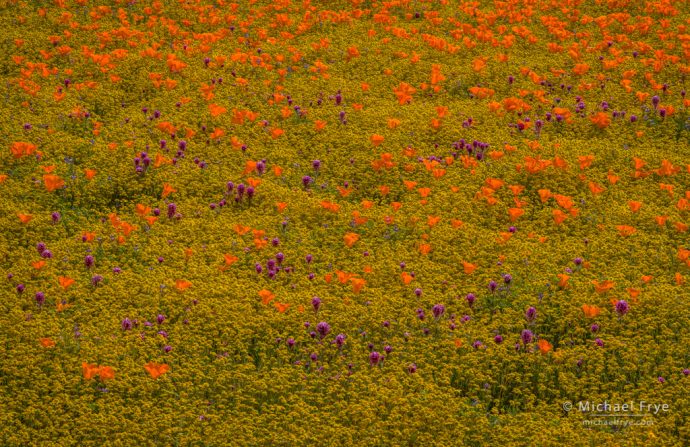
Goldfield carpet with poppies and owl’s clover, Antelope Valley, California. My eye was drawn to the pattern of poppies and owl’s clover poking out of the goldfields, so I used a telephoto lens (110mm) to compress the space and fill the frame with that pattern. 1/200th of a second at f/16, ISO 100 (focus-stacked during a lull in the wind)
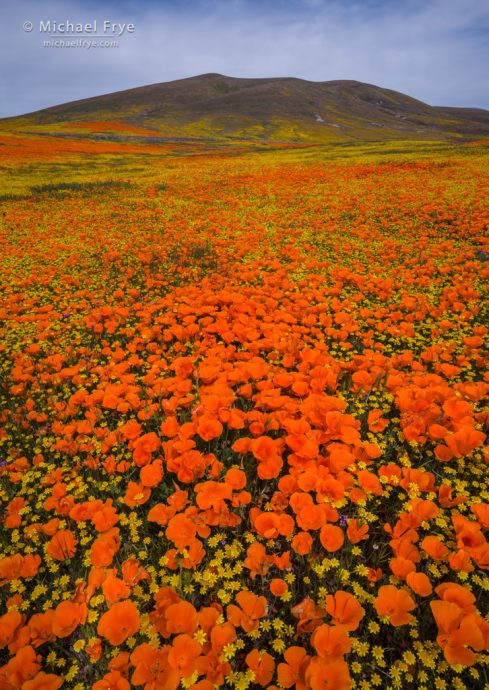
Poppies and goldfields, Antelope Valley, California. Another wide-angle, near-far composition. The dense clump of poppies in the foreground provided one focal point, the background hill added another. This was captured late in the morning, but some thin, high clouds softened the light for a few minutes, allowing me to capture fully-open poppies with not-too-harsh light. 23mm, 1/125th of a second at f/16, ISO 100.
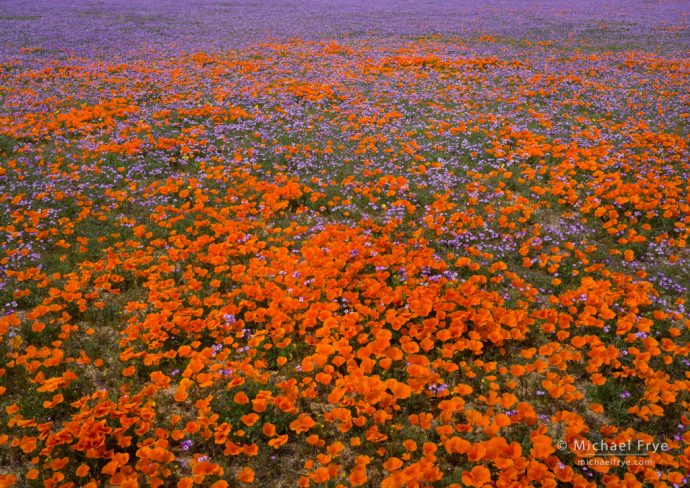
Poppies and gilia, Antelope Valley, California. It was really windy when I made this image, so I needed a fast shutter speed, and couldn’t get too close to the flowers yet still get everything in focus. So I used a high camera position and pointed the camera down, concentrating on the patterns of flowers. The clump of orange in the foreground creates a vague focal point, but this image is really more about patterns of color. 35mm, 1/250th of a second at f/16, ISO 250.
Related Posts: Color is not Enough; The Floweriest Piece of the World
Michael Frye is a professional photographer specializing in landscapes and nature. He is the author or principal photographer of The Photographer’s Guide to Yosemite, Yosemite Meditations, Yosemite Meditations for Women, Yosemite Meditations for Adventurers, and Digital Landscape Photography: In the Footsteps of Ansel Adams and the Great Masters. He has also written three eBooks: Light & Land: Landscapes in the Digital Darkroom, Exposure for Outdoor Photography, and Landscapes in Lightroom: The Essential Step-by-Step Guide. Michael has written numerous magazine articles on the art and technique of photography, and his images have been published in over thirty countries around the world. Michael has lived either in or near Yosemite National Park since 1983, currently residing just outside the park in Mariposa, California.









Wonderful pictures, Michael! It looks like the wildflower season has been very good this year all around the country.
Thanks Gabor. I know it was a good year for flowers in Arizona as well as California, but I haven’t heard about anywhere else.
It was exceptionally good in Texas too and some reports say that it’s going to be very special in Colorado as well.
Ah yes, I forgot about Texas. As for Colorado, I don’t count chickens that haven’t hatched yet. 🙂 Any attempt to predict the future is always risky!
Thanks for the lovely images, Michael, the Golden State seems particularly golden this year! I appreciate your comments about photographing flowers; I’ve found it very challenging over the years to get good compositions when facing fields of flowers. Your tips about patterns, focal points and filling the frame are very helpful. Cheers!
Thanks Bob, and I’m glad you found the article helpful.
Yum! You have once again captured such glorious floral wonders. It doesn’t get any better. With all the recent environmental events that have created destruction to California, the incredible wildflower blooms this Spring have brought a refreshing renewal of hope and unique beauty. Thanks for sharing the detailed steps taken to highlight such natural wonders.
Thanks so much Ann!
Oh man- what a joy! The last two pictures in the series are just mind blowing. An explosion, a colorful land grab!
Thanks very much Andrew!
Good Morning Michael
Thank you for the flowers this morning. I really like the focal point on the first image. I need to remember this one.
Roger
Thanks Roger!
Beautiful images, and thanks for the tips!! A question on your ISO choices: you commented about the wind factor on the photos you had your ISO at 250 or less. Why did you decide to use the lower ISO versus a higher one that would allow a faster shutter speed to reduce movement?
Thanks Tim. There’s no reason to use a higher ISO than needed, as that will just add noise unnecessarily. If you look at the shutter speeds for these photographs you’ll see that for all except the first image the shutter speed was 1/125th of a sec. or faster, which is plenty fast enough to freeze the motion of flowers waving in the wind.
Thanks for the explanation! I always like to find out the “why” behind the settings (not just the “how”). Again, beautiful images (especially the first)!!
You’re welcome Tim.
I have enjoyed your pictures and blurbs for several years now, but have a special attachment to the recent AV shots for several reasons. I was able to spend part of 4 days gawking at the poppies apparently the same time you were there, but not being a photographer, I was limited to my iPhone, which surprisingly did give me several great shots. But not enough. If you put together a series of images from your excursion there this year, I’d love to buy a copy. Do you do that? Also, wondering if you took any pictures from Munz Road which runs north/south into the Reserve on the east side. Great views but as you said, wind was usually a factor, and certainly gave additional limitations in what an iPhone could do. But I did get my favorite images from that road. Thanks, Michael.
Thanks Jayne. I’ve never put together a series for sale like that, but you can buy individual prints of any of my images. Here’s a link that shows the sizes and prices available:
https://www.michaelfrye.com/portfolios/print-ordering/
We didn’t go to Munz Road, but did explore many other backroads in the area.
Such a lovely selection of photographs and helpful advice, Michael. The second photo is magical. I absolutely love that it looks like colorful tundra at first glance but is in fact flowers. The hills also come together in a perfect pattern. So well done!
Thanks so much Sarah! I’m pretty happy with that image too. 🙂
Michael,
Your photos of the wildflowers are absolutely breathtaking, as were the recent photos taken in Death Valley. I have been to both sites in the recent past. You always offer a new perspective and a new way of viewing the subject matter. Thanks for bringing the wonderful world of nature onto my computer screen!
John
Thanks so much John – very kind words!
“WOW” These Images Are Awesome Michael, Colours So Beautiful, Like A Carpet Of Flowers, Will Check Out Antelope Valley On My Visit To USA Next Year, As We Will Be Also Visiting Yosemite NP & Yellowstone NP As Well As Monument Valley (Staying At The View). Your Photography Is So Beautiful & Natural.
Thanks John! Flower blooms are highly variable, so don’t expect Antelope Valley to be great next spring. And when Antelope Valley blooms (typically in early April), Yellowstone is still under snow!
Appreciated very much about your photos and your detailed explanation of doing them. We went there several times including the puppy field nearby. So the above is very helpful and educational.
By following your blog closely, I have learned a lot. Thanks.
Thanks very much William!